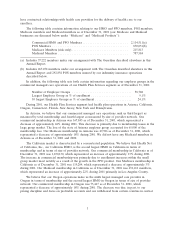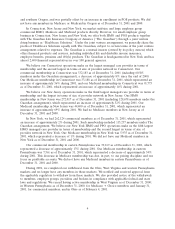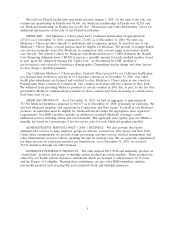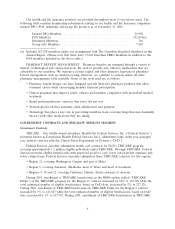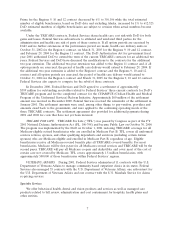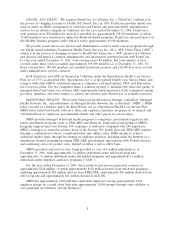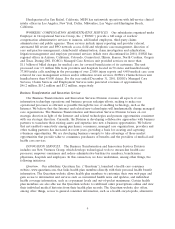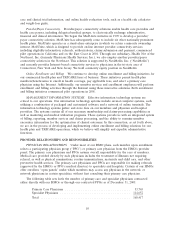Health Net 2001 Annual Report Download - page 14
Download and view the complete annual report
Please find page 14 of the 2001 Health Net annual report below. You can navigate through the pages in the report by either clicking on the pages listed below, or by using the keyword search tool below to find specific information within the annual report.development of distinct brand identities and innovative product service offerings that will appeal to
potential health plan members.
COMPETITION. HMOs operate in a highly competitive environment in an industry currently
subject to significant changes from business consolidations, new strategic alliances, legislative reform
and market pressures brought about by a better informed and better organized customer base. Our
HMOs face substantial competition from for-profit and nonprofit HMOs, PPOs, self-funded plans
(including self-insured employers and union trust funds), Blue Cross/Blue Shield plans, and traditional
indemnity insurance carriers, some of which have substantially larger enrollments and greater financial
resources than we do. We believe that the principal competitive features affecting our ability to retain
and increase membership include the range and prices of benefit plans offered, provider network,
quality of service, responsiveness to user demands, financial stability, comprehensiveness of coverage,
diversity of product offerings, and market presence and reputation. The relative importance of each of
these factors and the identity of our key competitors varies by market. We believe that we compete
effectively with respect to all of these factors.
We face competition from a variety of sources in the California health plan market. Kaiser
Foundation Health Plan (‘‘Kaiser’’) is the largest HMO in California and is a competitor of ours in the
California HMO industry. In addition to Kaiser, our other HMO competitors include PacifiCare of
California, California Care (Blue Cross of California) and Blue Shield of California. There are also a
number of other types of competitors including self-directed plans, traditional indemnity insurance
plans, and other managed care plans. Despite the concentration of membership in the large health
plans, the competitive environment in the state is also impacted by small, regional-based HMOs, whose
combined membership we believe constitutes approximately 20-25% of the market. In addition, we
compete in California against a variety of PPOs.
Our largest competitor in Arizona is Blue Cross/Blue Shield. Our Arizona HMO also competes
with United Healthcare, CIGNA, PacifiCare and Aetna. Our Oregon HMO competes primarily against
other HMOs including Kaiser, PacifiCare of Oregon, Providence, Blue Cross, Lifewise and Blue Shield
Regions, and with various PPOs.
Our HMO in Connecticut competes for business with commercial insurance carriers, Anthem
Connecticut, Aetna/U.S. Healthcare, Connecticare and eight other HMOs. Our main competitors in
Pennsylvania, New York and New Jersey are Aetna/U.S. Healthcare, Empire Blue Cross, Oxford Health
Plans, United Healthcare, Horizon Blue Cross and Keystone Health Plan East.
GOVERNMENT REGULATION. We believe we are in compliance in all material respects with
all current state and federal regulatory requirements applicable to the businesses being conducted by
our subsidiaries. Certain of these requirements are discussed below.
California HMO Regulations. California HMOs such as Health Net of California, Inc. (‘‘HN
California’’) and certain of our specialty plans are subject to California state regulation, principally by
the Department of Managed Health Care (‘‘DMHC’’) under the Knox-Keene Act. Among the areas
regulated by the Knox-Keene Act are: (i) adequacy of administrative operations, (ii) the scope of
benefits required to be made available to members, (iii) manner in which premiums are structured,
(iv) procedures for review of quality assurance, (v) enrollment requirements, (vi) composition of policy
making bodies to assure that plan members have access to representation, (vii) procedures for resolving
grievances, (viii) the interrelationship between HMOs and their health care providers, (ix) adequacy
and accessibility of the network of health care providers, (x) provider contracts, and (xi) initial and
continuing financial viability of the HMO and its risk-bearing providers. Any material modifications to
the organization or operations of HN California are subject to prior review and approval by the
DMHC. This approval process can be lengthy and there is no certainty of approval. Other significant
changes require filing with the DMHC, which may then comment and require changes. In addition,
13


